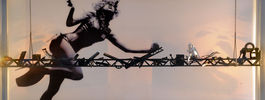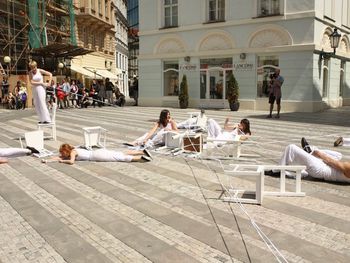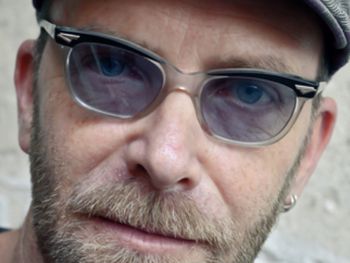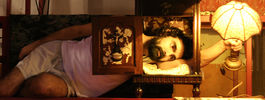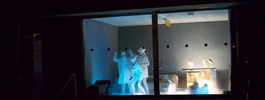Back
1979 » Finland » Stage and costume design
| Curator: | Paul Rafael Suominen |
FINSKO
Under the term stage designer in Finland we have in mind the creator of the visual aspects of a performance. In other words his denotes at present the designer of both the sets and costumes.
Finland is a country of theatres. With 4.5 million inhabitants, we have a total of over 59 permanent professional theatres. If we classify these theatres according to various criteria, we obtain the following table:
Permanent theatres playing in the Finnish language 31
Permanent theatres playing in the Swedish language 4
Traveling drama troupes 7
Traveling dance troupes 2
Opera 1
Operetta 1
Summer stock companies with their own stage 10
Amateur theatres with professional guidance 3
Besides these troupes there are many amateur groups functioning in various workers' and youth associations and also in other organizations.
The Finnish theatre is. a truly popular theatre. Working people and their organizations have, from the very beginning, formed the foundation of all theatrical activities. It has been found that the theatre is an ideal mediator in forming the ideas of people and gaining their convictions. From its very beginnings the spirit of the Finnish theatre has been collectively orientated.
A typical aspect of Finnish popular theatre is its sparse outer form. The grand manner of the court theater, so typical for southern and central Europe, have been quite alien to the Finnish theatre. The Finnish theatre could never count on the so called: Deus ex machina. It has always typically been steeped in realism, a cold headed seriousness end a hearty sense of humor. The position of Finland on the northern tip of Europe has led to the situation where the cultural activities of the Swedish upper classes, who ruled the country until the founding of the Republic in 1917, did not have any influence upon our popular culture. It was only at the end of the 19th century, at a time when one could already speak of a national revival in politics and about national romanticism in the arts, that the spiritual potential of the Finnish people made an impact upon the development of their own national culture.
This development had both its positive and negative aspects. Finnish popular culture has thus maintained its specific style and its strength. The human soul has remained protected against the trite pressures of commercial "reproduced“ culture. On the other hand, however, this to a certain extent contributed to the negative isolation of the theatre, especially in the technical field. Theatres whose current expenses were often covered by the small contributions of workers, rarely has sufficient money to spend on proper facilities. One might even say that these factors, which influence Finnish theatrical art even today, are the causes of the fact that the Finnish theatre is more similar to the stage used by Hans Sachs than to the one used by Gaily Babied.
After World War II the Finnish theatre made contact with the world the Fins were from the very beginning active members of international theatrical organizations. The activities of the International Theatrical Institute / ITI / and the international organization of stage designers and theatrical technicians / OISTT / have in many aspects served as an incentive for the development of the theatrical culture of individual member countries and thus for theatrical culture as a whole. Thus also thanks to the activities of these organizations the stage design and technical aspects of the Finnish theatre have improved proved and have led to the forming of a state approaching equilibrium, as far as the relation between art and technology are concerned.


Exhibiting artists / ateliers
[show all
| hide all]
- Paul Suominen (Paul Rafael Suominen)
Additional information: Born in 1930 in Helsinkl. In 1948 to 1953 he was trained in stage
design in the Svensk Teatern in Helsinki. In the years 1955-1973
he worked as a stage designer and costume designer at the Suomen
Kansallisooppera and occasionally also at the Lilla Teatern
under the guídance of Wivici Bandler. It was here that he designed
stage sets for Daria Fo, who directed his own plays. In
the period 1976-1977 he worked in the Stockholm Municipal Theatre.
Since 1973 he is head of the department of stage design at the
Academy of Applied Arts in Helsinki. In 1975 he received the
Bronz Medal at the Triannial of stage and costume design at Novi
Sad in Yugoslavia for his concept and realization of the stage
sets for Goethe' s Faust. He participated in the Prague Quadrennial
in 1975.
Obrázky z katalogu
- Kalevi LISKI
Additional information: Born in 1937 in Vuoksela. In 1962 he graduated from the Academy
of Applied Arts in stage design. He works as art director at
Finnish Television. He.has designed over 200 stage sets, above
all for opera, ballet and other musical performances. He also designs
sets for drama perfomances in television, for instance for
Shakespeare´ s Hamlet, for Brechť s Days of the Commune, and others.
He has received scholarships from the Finnish goverment and the
city of Helsinki, as well as other awards.
Obrázky z katalogu
- Pirjo Pulkinen (Pirjo Valinen)
* 27.02.1951, Rantasalmi
Specialization: teacher, set designer, costume designer
Education: Textile teacher, Helsinki University; compination of many theatre design courses organized by Helsinki Theatre Academy and Helsinki University of Art and Design (Aalto University)
Collaboration with theatres: Oulu City Theatre
Teaching activities: Aalto University in Helsinki, Kuopio Academy of Design, Savonia University of Applied Science, University of Oulu, University of Lappland, PQ'07 Scenofest, Usitt-05 Toronto
Participation in other important exhibitions: Theatre Museum in Helsinki (2006, 2010); The Craft Museum of Finland (2010); WSD-09 Soul; G.A. Serlachius Museum (2007); Proto, Stuttgart (2007); Stage Expo, USITT, Toronto (2005)
Awards: 2006 Theatre in Finland State Prize
- Tapio Rautanen
- Riina AHONEN
Additional information: Born in 1945 in Helsinki, costume designer. Between 1964 and 1972
sne worked as a sound engineer in the theatrical department of
the Finnish Broadcasting Company. She studied at the Academy of
Applied Arts in Helsinki /1972-75/, at the Academy of Performing
Arts in Prague /1975-76/ and at the Finnish Theatre School
/1977/. She designed costumes for Goethe' s Faust and for the play
The World is Still Young by E. Sinervo. Among her more important
work are costume designe for Molière' s The Miser, for the Porin
Teatteri, for Strindberg' s Master 0laf, for the Tampereen Työväenteatteri,
for García Lorca' s Rosita the Single, for Turun
Kaupunginteatteri and for Katz' Threeheaded Buddha, for the
Suomen Kansallisteatteri. She also works for films and television.
At the Triannial at Novi Sad in Yugoslavia in 1978 she received
a Silver Medal.
- Liisi Tandefelt
Additional information: Born in 1936, a costume designer and actress. She studied at the
Academy of Applied Arts, at the Finnish Theatre School and at the
Studio of Dramatic Art at Tampere. Since 1961 she is active as
an actress and costume designer. She has collaborated with foremost
Finnish theatres and with the Finnish Vleísradio. During
1961-63 she was at the Televlsion Theatre, then at the Tampereen
Tyovaenteatteri and at the Municipal Theatre of Helsinki. At
present she is working as a costume designer for the Municipal
Theatre in Turku. She participated in the Prague Quadrennial
in 1975.


